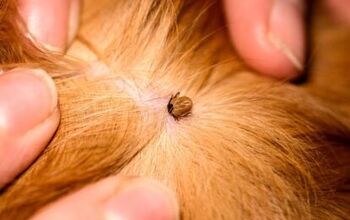What Do You Know About Whipworms In Dogs?

In spite of our loving diligence at providing Rover with top quality kibble and organic treats dogs are, quite frankly, not all that fussy when it comes to finding their own sources of food and beverage. As a result, intestinal worms abound and they are thankfully one of the most treatable – and preventable – parasites you and your buddy will have to tackle in his lifetime. While not topping the list of life-threatening species, whipworms are a tenacious predator that can hamper your pet’s ability to enjoy an active and healthy life when left unchecked or combined with other parasites.
Related: The Low-Down On Roundworms In Dogs
What Causes Whipworms in Dogs?
While fairly innocuous in terms of severity, whipworms in dogs are one of the most common and certainly the hardiest parasites you will encounter as a pet parent. Named for their tapered, whip-like shape, they are an intestinal parasite of two to three inches in length that feed off your pet’s blood by burrowing into the wall of his intestine. Surprisingly, their eggs do best in colder climates and are capable of living outside of a host for up to five years!
Related: What You Need To Know About Hookworms In Dogs
Your pet can contract whipworm by ingesting eggs found in soil, animal feces or by simply self-grooming. Once consumed, the eggs hatch and mature in his intestine over the next 10 to 12 weeks and because of this lengthy incubation period and the fact that female worms produce relatively few offspring, infestations are typically light. In small numbers (light infestations), whipworms cause few problems; however when left untreated, the resulting heavier infestation can result in chronic health problems for your pet.
While more common in older dogs than puppies, it is the latter which runs the greatest risk of becoming seriously ill from this parasite.
Symptoms of Whipworms in Dogs
If your pet has a light infestation, you are unlikely to notice any signs or symptoms. It isn’t until the whipworm population becomes heavier and inflammation of the large intestine occurs that you will notice diarrhea, blood in the stool, weight loss and in some extreme or chronic cases, pale gums and weakness as anemia presents.
It is important to understand that puppies infected with whipworm will almost certainly have a host of other parasites and the combination, if not dealt with swiftly, can be fatal.
Treatment Options and Prevention
Similar to other parasites, whipworm eggs can be identified through a microscopic examination of a stool sample (fecal flotation) by your vet. Because the female whipworm produces eggs infrequently, multiple tests may be required to establish the type of parasite infecting your pet. As a result, it would not be uncommon to begin a course of treatment even if whipworm is simply suspected.
Your vet can guide you to a number of safe and effective oral medications on the market and together you can pick the right product for your pet. As with most parasite treatments, you will need to be committed to repeating the process at regular intervals to ensure both the adult whipworm and the maturing larvae are killed.
Unfortunately, because the eggs have such a lengthy survival rate, there is a strong likelihood your pet could become re-infected from eggs still in the environment. For this reason, you may want to consider one of the monthly parasite treatments available on the market and effective in killing whipworms in dogs.
Mary Simpson is a writer and communications professional from Port Credit, Ontario. A soft touch for anything stray, she shares her century home with an eclectic collection of rescues that include orange tabby Chico, tuxedo Simon, and jet black Owen. She enjoys running, politics, exploring the wine regions of Niagara and is an avid supporter of the “shop local” movement.

Sharing space with three seriously judgy Schnoodles and a feline who prefers to be left alone. #LivingMyBestLife
More by Mary Simpson























